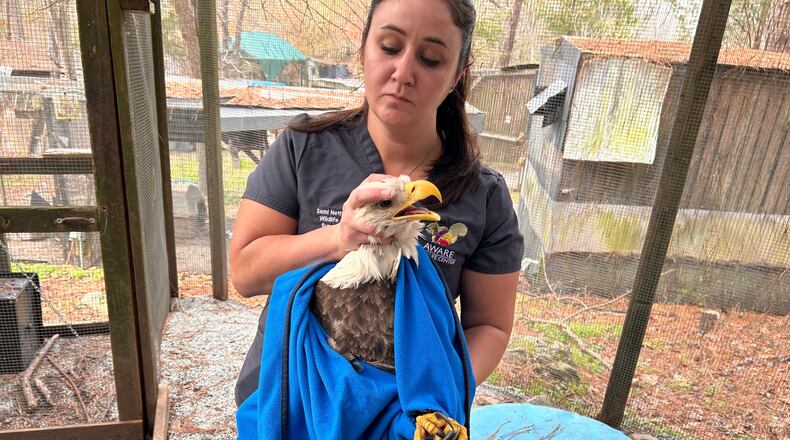Scott Lange was still shaking off sleep’s cobwebs on the first Sunday morning of December when the call came.
“We have a unique situation,” Panola Mountain State Park ranger Jarrod Simpson alerted over the phone. “There is an injured bald eagle down near Alexander Lake. Can AWARE help?”
AWARE (Atlanta Wild Animal Rescue Effort), the Stonecrest wildlife center where Lange is executive director, is used to fielding breathless calls from the public reporting injured bald eagles, but rarely are the sightings accurate. Usually, it’s a hawk or an owl; sometimes it’s not even a bird.
Credit: Handout
Credit: Handout
The center hadn’t taken in a bald eagle, the majestic and mystical creature that has served as America’s national bird since 1782, as a patient in nearly a decade. An Atlanta native, Lange himself had spotted only one bald eagle in the wild in all his 46 years, so he was naturally dubious. But the cool-under-pressure park ranger on the line said he was sure.
Lange grabbed some towels and a bin that could be used to safely capture and transport the injured creature, whatever it was, and hauled over to Panola Mountain State Park. When he arrived at the lake, where he would be aided by a volunteer crew of 20 nature lovers that had quickly assembled, he knew.
“It was unmistakable,” the AWARE leader wrote of the bald eagle several days later in an e-newsletter. “Once my eyes processed the sight, something else was unmistakable — his broken right wing, pointing off at a disconcerting angle.”
Nearly two weeks later, the drama is still unfolding for the eagle as well as for Lange and his staff at AWARE, the first center of its kind in Georgia to work to rescue and nurse back to health all species when it opened in 2006. But things are looking positive for the eagle whose injuries, his rescuers believe, were sustained by a collision with a vehicle.
Surgery the day after capture to repair the eagle’s broken humerus, performed by veterinarian Dr. Holly Burchfield with AWARE’s Director of Animal Care Marjan Ghadrdan, was successful beyond expectation. The caregivers hope that the wing, which had been twisted 360 degrees, can be saved instead of amputated.
Credit: Handout
Credit: Handout
Still, “the most likely outcome is that he is non-releasable because his flight will be limited,” Lange said. “In that case, we will place him at an educational facility or sanctuary.”
Lange would be happy if the bird migrates to the Citizen Potawatomi Nation Eagle Aviary in Oklahoma, where Archer, a bald eagle that AWARE rescued and rehabbed in 2011, continues to prosper. But any decision will be made in concert with the U.S. Fish and Wildlife Service and the Georgia Department of Natural Resources, two of the agencies that oversee AWARE’s work.
Credit: Handout
Credit: Handout
Between continued care and that placement, it could be springtime before this patient weighing seven pounds and with an estimated 7-foot wingspan departs AWARE’s chockablock headquarters in a rearranged 1970s ranger’s cabin at the base of Arabia Mountain. That’s fine with the staff, which has become smitten with the unnamed eagle.
“He’s been a dream as a patient,” Ghadrdan said one recent day around lunchtime. She and Wildlife Care Supervisor Sami Netherton had just administered anti-inflammatory and antibiotic pills, which they helped the bird swallow with liquid medication from plastic syringes and by massaging under his jaw. They carefully handled the eagle to ensure that it inflicted no damage with its sharp beak or strong talons. Their concentration was such that they weren’t distracted by the spectacle of a vulture — an animal “ambassador” for school and weekend tour groups, who was exercising and getting socialization time on the floor of the adjoining room — flapping its wide wings while happily flinging a black sock into the air again and again.
“From day one he’s been eating all his food,” Ghadrdan continued of AWARE’s biggest avian occupant. “Usually, birds display some level of anorexia when they first come from the outside to inside like this. He’s been calm in his enclosure and not trying to injure himself. He just hangs out on his perch. He gets a little feisty at medicine-taking times, but he really has taken the whole thing very well.”
What’s for lunch? A mixture of mice, rats, baby chicks and fish that AWARE purchases to feed its patients.
“Honestly, I gave him all those items to see what he would like, and he likes all of them, Ghadrdan noted. “So, I was like, ‘Whatever. You can have whatever you want!’”
Though it seems unpardonably generic to refer to the regal bird by its species instead of by a name, Lange explained that the wildlife center treats patients like they are wild. There is no “bunny hugging,” as he calls it, such as using cutie-pie names or baby-talking.
Credit: Handout
Credit: Handout
Still, the staff is excited about this week’s milepost in the eagle’s recovery ,when the surgical wrap protecting its injury is removed and the healing of his mostly hollow bones can be evaluated.
It might help relieve the sadness of knowing that the bald eagle had what they believe was a mate. AWARE staffer Marielle Kromis spotted her flying around Panola Mountain on the morning of the rescue. The pair’s white heads indicate that each is at least 5 years old, the age when bald eagles begin to breed.
“They tend to have long-term monogamous relationships,” Lange explained. “It is sad to think about that eagle losing (her) partner because this eagle is not going to be releasable.”
Trying to find the positive, Ghadrdan added, “For him to make it five years and to start to breed, it just shows that he’s strong and did well. Most raptors die in their first year of life, because it’s rough out there.”
About the Author
Keep Reading
The Latest
Featured




